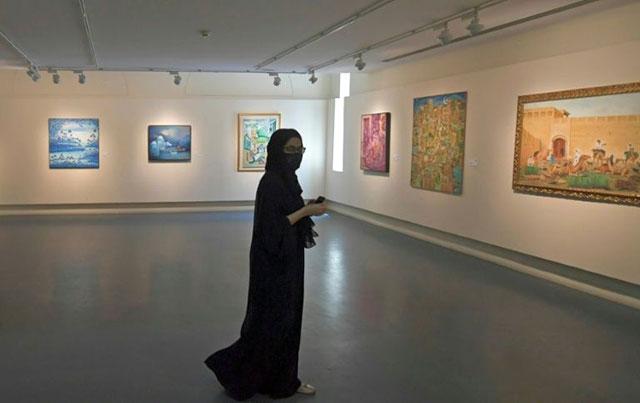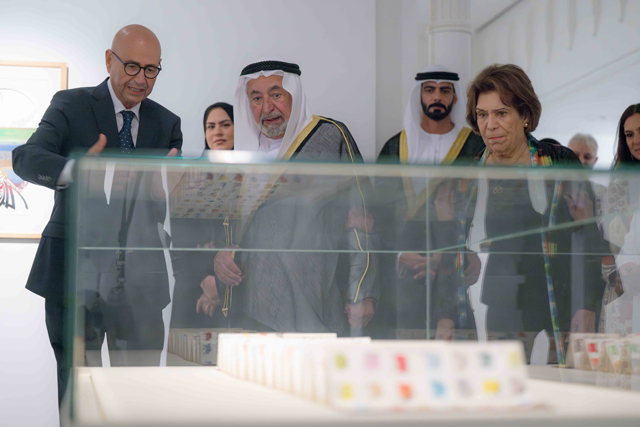You are here
Beyond Dubai’s shadow, Sharjah shines light on Arab art
By AFP - Nov 04,2020 - Last updated at Nov 04,2020

Work depicting daily life in Yemen’s Old City of Sanaa come alive in the Gulf emirate of Sharjah (AFP photo)
SHARJAH, United Arab Emirates — It does not have the malls of Dubai or the mega-projects of Abu Dhabi, but the conservative Gulf emirate of Sharjah has carved out a role for itself as a cultural capital.
The unassuming emirate, often overlooked by visitors in favour of its glitzier neighbours, is ruled by Sheikh Sultan Bin Mohamed Al Qasimi, known for his keen interest in art and history.
Its cultural calendar has evolved to feature book fairs, exhibitions at more than a dozen museums and festivals that celebrate photography, theatre, poetry and calligraphy.
“We are providing an artistic service for the Arab world,” said Sultan Sooud Al Qassemi, a well-known Emirati academic with half a million followers on Twitter, strolling through the galleries.
The Barjeel Art Foundation which he founded in 2010 aims to preserve and exhibit more than 1,000 modern and contemporary pieces by Arab artists.
“Sharjah is not the richest emirate in the Gulf, but it is in terms of being the richest culturally,” said the 42-year-old who has taught in universities in the United States and France.
‘Go local’
Sharjah is one of the seven emirates that make up the United Arab Emirates, an innovative and oil-rich country which has poured huge sums into culture.
In 2017, the Louvre Abu Dhabi, a branch of the iconic Paris museum, opened its doors — attracting some 2 million visitors in its first two years of operation.
The financial and entertainment hub of Dubai hosts a number of contemporary art galleries, and is next year to host the multi-billion-dollar world exhibition — Expo 2020 — with major arts components.
Its place on the global art scene has been sealed by the Sharjah Biennial, a large-scale exhibition of contemporary works which it hosts every two years.
“For a desert, Sharjah is an uncommonly fertile location for a biennial. There are countless untapped histories in the land and surrounding waters — and just as many suppressed ones,” ARTnews magazine said.
UNESCO named Sharjah the cultural capital of the Arab world in 1998 and last year it was declared the World Book Capital.
And the emirate this week launched the Sharjah International Literary Agency, a first in the Gulf, with the goal of promoting Emirati and Arab writers.
“It’s very easy to continue to support artists from Europe, but it’s our artists here that need our support, resources and confidence, said Manal Ataya, director general of the Sharjah Museums Authority.
“There’s been an under-representation of Arab artists globally,” she told AFP.
Qassemi said the eureka moment that inspired his collection came when he saw crowds flocking to view a Van Gogh at Paris’s renowned Musee d’Orsay.
“I told myself one day I will see such a queue of people wanting to view the works of the best Arab artists,” he said.
“The Arab world is rich in art... Unfortunately many young Arabs are not aware of it.
“We must fight against Western domination and the orientalist vision of the Arab world. We must know local art and Arab artists before we learn about Picasso and Dali.”
Moza Almatrooshi, a young Emirati sculptor, has set up shop in Sharjah where her quaint studio overlooks the museum, flanked by bright low-rise buildings.
Originally from the nearby emirate of Ajman, she splits her time between London and Sharjah, which she describes as “human-size” and the UAE’s most habitable city.
“I worked in Dubai for a little while and felt that the art there was more focused on being commercial, and my art practice is not very commercial,” said Almatrooshi, whose creations focus on everyday life and culinary traditions.
With only a few skyscrapers in sight, Sharjah’s alleyways and old buildings are an “inspiration”, she said.
By Aziz Al Massassi
Related Articles
AMMAN — Sheikh Sultan bin Muhammad Al Qasimi, Member of the Supreme Council and Ruler of Sharjah, on Wednesday officially opened the exhibit
AMMAN — A new exhibition at the Widad Kawar Home for Arab Dress is showcasing the artwork of the Naqsh Collective, which combines traditiona
AMMAN — As part of its “Lasting Impressions” series, Sharjah Museums Authority (SMA) is organising the first solo exhibition held in the Ara


















